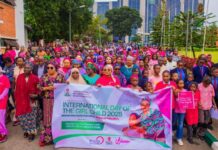
United Nations Inter-Agency Group for Child Mortality Estimation, UN IGME, has revealed that 4.9m Underage deaths globally concentrates in sub-Saharan Africa and southern Asia.
READ ALSO: NAWOJ marks International Women’s Day 2024 with- urgent call to end FGM
“This tragic loss of life is primarily due to preventable or treatable causes, such as preterm birth, complications around the time of birth, pneumonia, diarrhoea, and malaria. Many lives could have been saved with better access to high-quality primary health care, including essential, low-cost interventions, such as vaccinations, availability of skilled health personnel at birth, support for early and continued breastfeeding, and diagnosis and treatment of childhood illnesses.”
The UN IGME report further revealed that more children are surviving today than ever before, with the global under-5 mortality rate declining by 51 percent since 2000.
It noted that several low- and lower-middle-income countries have outpaced the decline, showing that progress is possible when resources are sufficiently allocated to primary health care, including child health and well-being.
The findings in the report show that Cambodia, Malawi, Mongolia, and Rwanda have reduced under-5 mortality by over 75 percent since 2000.
However, it further showed that despite the progress, there is still a long road ahead to end all preventable child and youth deaths.
“In addition to the 4.9 million lives lost before the age of 5 – nearly half of which were newborns, the lives of another 2.1 million Children and youth aged 5–24 were also cut short.
Reacting to the UN IGME report, UNICEF Executive Director Catherine Russell said: “Behind the numbers lie the stories of midwives and skilled health personnel helping mothers safely deliver their newborns, health workers vaccinating and protecting children against deadly diseases, and community health workers who make home visits to support families to ensure the right health and nutrition support for children.”
Russell added that through decades of commitment by individuals, communities, and nations to reach children with low-cost, quality, and effective health services, they have shown that they have the knowledge and tools to save lives.
On his part, WHO Director General, Dr Tedros Adhanom Ghebreyesus said while there has been welcome progress, every year millions of families still suffer the devastating heartbreak of losing a child, often in the very first days after birth.
He said: “Where a child is born should not dictate whether they live or die. It is critical to improve access to quality health services for every woman and child, including during emergencies and in remote areas.”
He noted that improving access to quality health services and saving children’s lives from preventable deaths requires investment in education, jobs, and decent working conditions for health workers to deliver primary health care, including community health workers.
As trusted community members, community health workers play an important role in reaching children and families in every community with life-saving health services like vaccinations, testing and medicine for deadly yet treatable illnesses, and nutrition support. They should be integrated into primary health care systems and paid fairly, well trained, and equipped with the means to provide the highest quality of care.
Studies show that child deaths in the highest-risk countries could drop substantially if community-based child survival interventions could reach those in need. This package of interventions alone would save millions of children and would deliver care closer to home. Integrated management of childhood illnesses – especially the leading causes of post-neonatal death, acute respiratory infections, diarrhoea, and malaria – is needed to improve child health and survival.
The Global Director for Health, Nutrition and Population, at World Bank & Director, of the Global Financing Facility for Women, Children and Adolescents, Dr. Juan Pablo Uribe, explained that this year’s UN IGME report is an important milestone showing that fewer children die before their fifth birthday.
“But this is simply not enough. We need to accelerate progress with more investments, collaboration and focus to end preventable child deaths and honour our global commitment. We owe it to all children to ensure they have access to the same health care and opportunities, regardless of where they are born.”
“While the global numbers show welcome signs of progress, there are also substantive threats and inequities that jeopardize child survival in many parts of the world. These threats include increasing inequity and economic instability, new and protracted conflicts, the intensifying impact of climate change, and the fallout of COVID-19, which could lead to stagnation or even reversal of gains and the continued needless loss of children’s lives. Children born into the poorest households are twice as likely to die before the age of 5 compared to the wealthiest households, while children living in fragile or conflict-affected settings are almost three times more likely to die before their fifth birthday than children elsewhere.
The United Nations Under-Secretary-General for Economic and Social Affairs, Li Junhua, said: “The new estimates show that strengthening access to high-quality health care, especially around the time of birth, helps to reduce mortality among children under age 5.
“While the milestones in the reduction of child mortality are important to track progress, they should also remind us that further efforts and investments are needed to reduce inequities and end preventable deaths among newborns, children, and youth worldwide.”
At current rates, 59 countries will miss the SDG under-5 mortality target, and 64 countries will fall short of the newborn mortality target. goal. That means an estimated 35 million children will die before reaching their fifth birthday by 2030, a death toll that will largely be borne by families in sub-Saharan Africa and Southern Asia or in low- and lower-middle-income countries.
The report also notes large gaps in data, particularly in sub-Saharan Africa and Southern Asia, where the mortality burden is high. Data and statistical systems must be improved to better track and monitor child survival and health, including indicators on mortality and health via household surveys, birth and death registration through Health Management Information Systems (HMIS), and Civil Registration and Vital Statistics (CRVS).
















